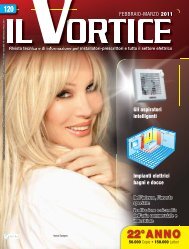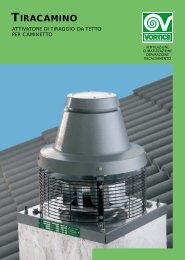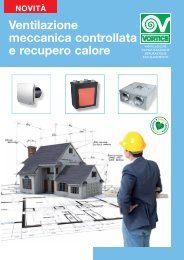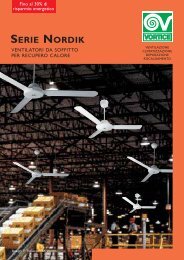l'aspirazione perimetrale Trend di mercato - Vortice
l'aspirazione perimetrale Trend di mercato - Vortice
l'aspirazione perimetrale Trend di mercato - Vortice
Create successful ePaper yourself
Turn your PDF publications into a flip-book with our unique Google optimized e-Paper software.
Metodo <strong>di</strong> prova per la verifi ca <strong>di</strong> conformità<br />
al Regolamento CE n° 327/2011<br />
Per la verifi ca alla conformità dei Ventilatori con<br />
potenza nel punto <strong>di</strong> massima effi cienza compresa<br />
tra 125W e 500 kW a seconda del tipo <strong>di</strong> ventilatore<br />
e della potenza in gioco, si utilizzeranno formule<br />
<strong>di</strong>fferenti a seconda della categoria del ventilatore.<br />
• Categoria A: se il ventilatore ha aspirazione libera<br />
e mandata libera.<br />
• Categoria B: se il ventilatore ha aspirazione libera<br />
e mandata in tubazione.<br />
• Categoria C: se il ventilatore ha aspirazione attraverso<br />
una tubazione e mandata libera.<br />
• Categoria D: se il ventilatore ha aspirazione e<br />
mandata in tubazione.<br />
Affi nché il regolamento sia sod<strong>di</strong>sfatto il ren<strong>di</strong>mento<br />
aeraulico del ventilatore in prova �e dovrà<br />
risultare uguale o maggiore del ren<strong>di</strong>mento target<br />
�tg calcolato.<br />
Le formule da utilizzare per il calcolo del ren<strong>di</strong>-<br />
tipo <strong>di</strong> ventilatori<br />
venitlatore assiale<br />
ventilatore centrifugo a pale<br />
curve in avanti e ventilatore<br />
centrifugo a pale ra<strong>di</strong>ali<br />
ventilatore centrifugoa pale<br />
rovesce senza contenitore<br />
ventilatore centrifugo apale<br />
rovesce con contenitore<br />
ventilatore a fl usso misto<br />
ventilatore a fl usso<br />
incrociato<br />
categoria<br />
<strong>di</strong> misura<br />
(A-D)<br />
categorie<br />
<strong>di</strong><br />
effi cienza<br />
(statica o<br />
totale)<br />
A,C statica<br />
B,D totale<br />
A,C statica<br />
B,D totale<br />
A,C statica<br />
A,C statica<br />
B,D totale<br />
A,C statica<br />
B,D totale<br />
B,D totale<br />
mento target (�tg) sono quelle riportate nella tabella<br />
1 e tabella 2 qui riportate dell’allegato I del<br />
regolamento sono funzione della potenza assorbita<br />
dalla macchina (Pe) nel suo punto <strong>di</strong> massimo ren<strong>di</strong>mento<br />
espressa in kW.<br />
Il ren<strong>di</strong>mento aeraulico dei ventilatori si calcola<br />
me<strong>di</strong>ante il rapporto:<br />
�e = Pu / Pe<br />
dove Pu potenza aeraulica del ventilatore dato<br />
dal prodotto della portata espressa in m 3 /s e della<br />
pressione espressa in Pa nel punto <strong>di</strong> massima<br />
effi cienza e Pe è la potenza elettrica assorbita nel<br />
medesimo punto <strong>di</strong> massima effi cienza espressa<br />
in W.<br />
q (m 3 /s)*p(Pa)<br />
�e = -------------------w<br />
intervallo <strong>di</strong><br />
potenza P in<br />
kW<br />
effi cienza energetica obiettivo<br />
0,125 ≤ P ≤ 10 �target = 2,74 . ln(P) - 6,33 + N<br />
10 ≤ P ≤ 500 �target = 0,78 . ln(P) - 1,88 + N<br />
0,125 ≤ P ≤ 10 �target = 2,74 . ln(P) - 6,33 + N<br />
10 ≤ P ≤ 500 �target = 0,78 . ln(P) - 1,88 + N<br />
0,125 ≤ P ≤ 10 �target = 2,74 . ln(P) - 6,33 + N<br />
10 ≤ P ≤ 500 �target = 0,78 . ln(P) - 1,88 + N<br />
0,125 ≤ P ≤ 10 �target = 2,74 . ln(P) - 6,33 + N<br />
10 ≤ P ≤ 500 �target = 0,78 . ln(P) - 1,88 + N<br />
0,125 ≤ P ≤ 10 �target = 4,56 . ln(P) - 10,5 + N<br />
10 ≤ P ≤ 500 �target = 1,1 . ln(P) - 2,6 + N<br />
0,125 ≤ P ≤ 10 �target = 4,56 . ln(P) - 10,5 + N<br />
10 ≤ P ≤ 500 �target = 1,1 . ln(P) - 2,6 + N<br />
0,125 ≤ P ≤ 10 �target = 4,56 . ln(P) - 10,5 + N<br />
10 ≤ P ≤ 500 �target = 1,1 . ln(P) - 2,6 + N<br />
0,125 ≤ P ≤ 10 �target = 4,56 . ln(P) - 10,5 + N<br />
10 ≤ P ≤ 500 �target = 1,1 . ln(P) - 2,6 + N<br />
0,125 ≤ P ≤ 10 �target = 4,56 . ln(P) - 10,5 + N<br />
10 ≤ P ≤ 500 �target = 1,1 . ln(P) - 2,6 + N<br />
0,125 ≤ P ≤ 10 �target = 1,14 . ln(P) - 2,6 + N<br />
10 ≤ P ≤ 500 �target = N<br />
il valore <strong>di</strong> ren<strong>di</strong>mento trovato va confrontato con<br />
il ren<strong>di</strong>mento target calcolato prima. Se il valore<br />
trovato risulta uguale o maggiore del ren<strong>di</strong>mento<br />
target allora il ventilatore è conforme al regolamento<br />
stesso. Per poter calcolare il ren<strong>di</strong>mento<br />
target è necessario <strong>di</strong>sporre:<br />
• della curva completa Portata vs Pressione del<br />
ventilatore oggetto della verifi ca<br />
• della curva del ren<strong>di</strong>mento aeraulico<br />
• della curva rappresentativa della potenza assorbita<br />
dalla macchina.<br />
SPECIFICHE MINIME DI EFFICIENZA ENERGETICA PER I VENTILATORI<br />
TABELLA 1 - PRIMA FASE DAL 1° GENNAIO 2013<br />
TABELLA 2<br />
grado <strong>di</strong><br />
effi cienza<br />
(N)<br />
36<br />
50<br />
37<br />
42<br />
58<br />
58<br />
61<br />
47<br />
58<br />
13<br />
grado <strong>di</strong><br />
effi cienza<br />
(N)<br />
40<br />
58<br />
44<br />
49<br />
62<br />
61<br />
64<br />
50<br />
62<br />
21<br />
SECONDA FASE DAL 1° GENNAIO 2015<br />
Il <strong>Vortice</strong> n. 130 - novembre 2012






